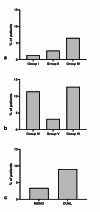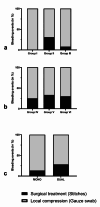Influence of antiplatelet medication and anticoagulation therapy after dental extractions on hospitalization: a retrospective 10-year study
- PMID: 39673056
- PMCID: PMC11645788
- DOI: 10.1186/s12903-024-05275-6
Influence of antiplatelet medication and anticoagulation therapy after dental extractions on hospitalization: a retrospective 10-year study
Abstract
Background: The aim of this retrospective study was to identify high-risk dental extraction patients and the timing of postoperative hemorrhage to evaluate whether preventive hospitalization should be considered in patients on antiplatelet medication (AP) or anticoagulants.
Methods: Our study included 1595 procedures; 1319 were conducted under monotherapy (Group I: AP; Group II: indirect oral anticoagulant [IAC]; Group III: direct oral anticoagulant [DOAC]) and 276 under dual therapy (Group IV: double AP; Group V: AP and IAC; Group VI: AP and DOAC). We evaluated the incidence, frequency and timing of hemorrhage, hospitalization rate, and treatment of bleeding incidents.
Results: The incidence of hemorrhagic events was significantly higher in the dual therapy groups compared to the monotherapy groups (p < 0.001). Comparing the procedures under monotherapy, those on DOAC (Group III) had a significantly higher risk of postoperative bleeding than Groups I and II (p < 0.001) and a higher rate of repeated bleeding episodes (p = 0.035). Regarding bleeding incidents, 44% (dual therapy) vs. 51.1% (monotherapy) occurred on the day of surgery.
Conclusions: The bleeding risk after dental extractions is overall low and patients were often hospitalized preventively due to their comorbidities rather than actual bleeding risk. Patients should be instructed about local compression, and surgeries should be completed in the morning to avoid emergency visits. However, patients with cardiovascular diseases and dual therapy had a higher risk of postoperative hemorrhage. Thus, hospitalization is to be considered in these cases.
Trial registration: The study was approved by the Ethics Committee of the Medical Faculty of RWTH Aachen (Decision Number 24-136). This was a retrospective clinical study designed to analyze postoperative bleeding and hospitalization rates after dental extractions in patients on AP or anticoagulation therapy.
Keywords: Antiplatelet therapy; Dental extraction; Hospitalization; Oral anticoagulation; Postoperative bleeding; Risk patients.
© 2024. The Author(s).
Conflict of interest statement
Declarations. Consent for publication: Not applicable. Competing interests: The authors declare no competing interests. Ethical approval: The study was approved by the Ethics Committee of the Medical Faculty of RWTH Aachen (Decision Number 24–136). Consent to participate: Not applicable.
Figures


References
-
- Kämmerer PW A-NBea. German S3 guidelines for the management of anticoagulation and anti-platelet therapy in dental surgery. 2017.
-
- Lockhart PB, Gibson J, Pond SH, Leitch J. Dental management considerations for the patient with an acquired coagulopathy. Part 2: Coagulopathies from drugs. Br Dent J. 2003;195(9):495–501. - PubMed
MeSH terms
Substances
LinkOut - more resources
Full Text Sources
Medical

